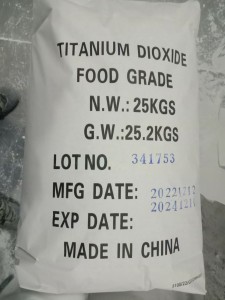Food-Grade Titanium Dioxide: Properties, Applications, and Safety Considerations
Introduction:
Titanium dioxide (TiO2) is a naturally occurring mineral that has been widely used as a white pigment in various industrial applications for its excellent opacity and brightness. In recent years, titanium dioxide has also found its way into the food industry as a food additive, known as food-grade titanium dioxide. In this essay, we will explore the properties, applications, safety considerations, and regulatory aspects of food-grade titanium dioxide.
Properties of Food-Grade Titanium Dioxide:
Food-grade titanium dioxide shares many properties with its industrial counterpart, but with specific considerations for food safety. It typically exists in the form of a fine, white powder and is known for its high refractive index, which gives it excellent opacity and brightness. The particle size of food-grade titanium dioxide is carefully controlled to ensure uniform dispersion and minimal impact on texture or taste in food products. Additionally, food-grade titanium dioxide is often subjected to rigorous purification processes to remove impurities and contaminants, ensuring its suitability for use in food applications.
Production Methods:
Food-grade titanium dioxide can be produced using both natural and synthetic methods. Natural titanium dioxide is obtained from mineral deposits, such as rutile and ilmenite, through processes like extraction and purification. Synthetic titanium dioxide, on the other hand, is manufactured through chemical processes, typically involving the reaction of titanium tetrachloride with oxygen or sulfur dioxide at high temperatures. Regardless of the production method, quality control measures are essential to ensure that food-grade titanium dioxide meets stringent purity and safety standards.
Applications in the Food Industry:
Food-grade titanium dioxide serves primarily as a whitening agent and opacifier in a wide range of food products. It is commonly used in confectionery, dairy, baked goods, and other food categories to enhance the visual appeal and texture of food items. For example, titanium dioxide is added to candy coatings to achieve vibrant colors and to dairy products like yogurt and ice cream to improve their opacity and creaminess. In baked goods, titanium dioxide helps create a bright, uniform appearance in products like frosting and cake mixes.
Regulatory Status and Safety Considerations:
The safety of food-grade titanium dioxide is a subject of ongoing debate and regulatory scrutiny. Regulatory agencies around the world, including the Food and Drug Administration (FDA) in the United States and the European Food Safety Authority (EFSA) in Europe, have evaluated the safety of titanium dioxide as a food additive. While titanium dioxide is generally recognized as safe (GRAS) when used within specified limits, concerns have been raised about the potential health risks associated with its consumption, particularly in nanoparticle form.
Potential Health Effects:
Studies have suggested that titanium dioxide nanoparticles, which are smaller than 100 nanometers in size, may have the potential to penetrate biological barriers and accumulate in tissues, raising concerns about their safety. Animal studies have shown that high doses of titanium dioxide nanoparticles may cause adverse effects on the liver, kidneys, and other organs. Furthermore, there is evidence to suggest that titanium dioxide nanoparticles may induce oxidative stress and inflammation in cells, potentially contributing to the development of chronic diseases.
Mitigation Strategies and Alternatives:
To address concerns about the safety of food-grade titanium dioxide, efforts are underway to develop alternative whitening agents and opacifiers that can achieve similar effects without the potential health risks. Some manufacturers are exploring natural alternatives, such as calcium carbonate and rice starch, as replacements for titanium dioxide in certain food applications. Additionally, advances in nanotechnology and particle engineering may offer opportunities to mitigate the risks associated with titanium dioxide nanoparticles through improved particle design and surface modification.
Consumer Awareness and Labeling:
Transparent labeling and consumer education are essential for informing consumers about the presence of food additives like titanium dioxide in food products. Clear and accurate labeling can help consumers make informed choices and avoid products containing additives to which they may have sensitivities or concerns. Furthermore, increased awareness of food additives and their potential health implications can empower consumers to advocate for safer and more transparent food supply chains.
Future Outlook and Research Directions:
The future of food-grade titanium dioxide hinges on ongoing research efforts to better understand its safety profile and potential health effects. Continued advancements in nanotoxicology, exposure assessment, and risk assessment will be critical for informing regulatory decision-making and ensuring the safe use of titanium dioxide in food applications. Additionally, research into alternative whitening agents and opacifiers holds promise for addressing consumer concerns and driving innovation in the food industry.
Conclusion:
Food-grade titanium dioxide plays a vital role in the food industry as a whitening agent and opacifier, enhancing the visual appeal and texture of a wide range of food products. However, concerns about its safety, particularly in nanoparticle form, have prompted regulatory scrutiny and ongoing research efforts. As we continue to explore the safety and efficacy of food-grade titanium dioxide, it is essential to prioritize consumer safety, transparency, and innovation in the food supply chain.
Post time: Mar-02-2024

